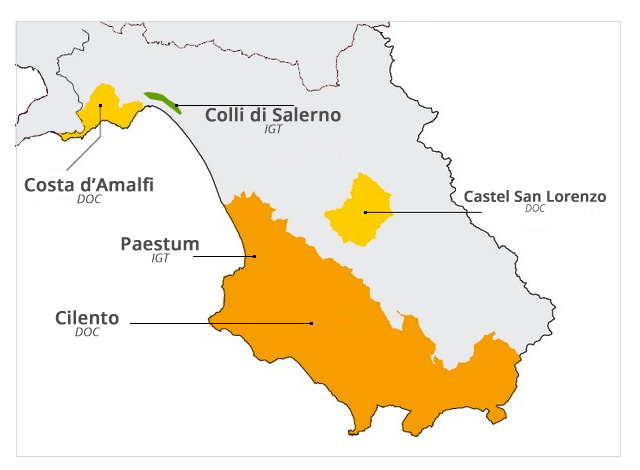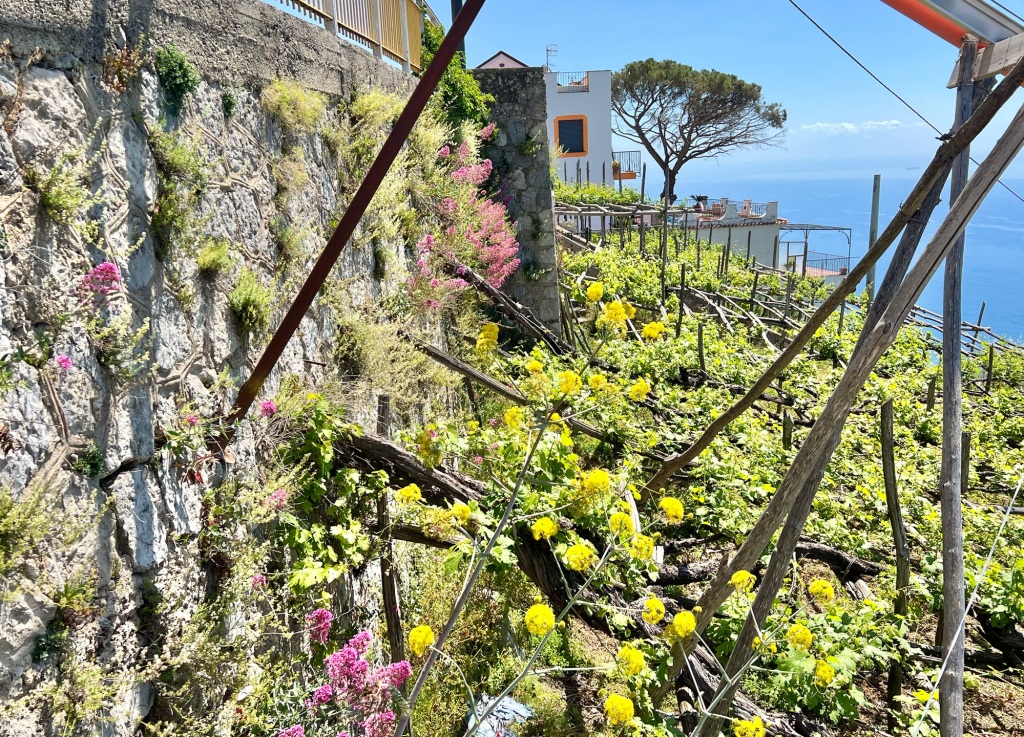
This is the second part of the tour that I organized as a member of the Dutch association of Vinologists (Verenigde Vinologen Nederland). After a day of getting to know the wines of Sannio, we continued our exploration of Campanian wine at the Costa d’Amalfi. The Amalfi coast is famous for its beautiful scenery, but it also has great wines.

Costa d’Amalfi is the only wine production area within the province of Salerno that we visited during this tour. It specializes in old vines of rare autochtonous grape varieties. Costa d’Amalfi DOC was established in 1995.

The vines grow on terraces on the steep slopes that end in the sea. This is clearly a case of ‘heroic viticulture’, as the slopes are very steep and the grapes need to carried in baskets on narrow trails with lots of steps. Only locals can work safely in the vineyards, as they have grown up here and know how to move around without falling. The vines grow between 100 and 700 meters above sea level. The grapes ripen first close to the sea, where it is the warmest.

There are some seriously old vines here. In the photo can you see one that grows horizontally out of the rock wall. The vines are in trained in pergolas. This often permits the farmers to grow other crops underneath, but here at the Costa d’Amalfi that is not always possible, as the soil is not always deep or fertile enough that.
Marisa Cuomo

The first winery we visited was Marisa Cuomo, a family business in the town of Furore. They have excavated a cave in the rock behind the winery to create a cellar. The winery that we visited is only used to make the reds, the whites are produced at another winery. Marisa Cuomo produces only 100,000 bottles per year, but has 11 different wines. They make wine from 46 hectares (130 acres), of which they own 3.5 hectares, rent 20 hectares, and they buy the grapes from the 63 families that own the remaining 22.5 hectares. The smallest only has 20 square meters. Marisa Cuomo employes an agronomist that helps all of the growers. The soil is limestone in all of the vineyards, but the altitude and exposure is different.

The red wines, which we did not taste, are made from Aglianico and Piedirosso. The Costa d’Amalfi Furore Rosso is made from 50% Aglianico and 50% Piedirosso, and is aged for 6 months in French oak barriques that have been used once before. The Costa d’Amalfi Ravello Rosso Riserva is made from 70% Aglianico and 30% Piedirosso. It is aged for 12 months in new French barriques. They destem all of the grapes for the red, as the Aglianico is already very high in tannins without the stems.

We did taste two of the white wines:
- Costa d’Amalfi Furore Bianco DOC 2022 (Falanghina 60%, Biancolella 40%, aged 4 months in stainless steel): fresh, salty, balanced.
- Fiorduva Costa d’Amalfi Furore Bianco 2017 (Fenile 30%, Ginestra 30%, Ripoli 40%, 95 year old vines, aged 4 months in new French oak): aromatic, complex, balanced. Ripoli provides elegance, Ginestra provides acidity, and Fenile fruitiness.
As an aperitif before lunch we also had a sparkling wine of a rare autochtonous grape variety called Caprettone (large male goat) that is grown on the slopes of the Vesuvius volcano, the 2020 Pietrafumante Caprettone spumante metodo classic millesimato brut by Casa Setaro.

We had lunch at Baccofurore just below the winery, with a beautiful seaview.

We tasted the two white wines described above with lunch, that consisted of an appetizer of ricotta with anchovies, a primo piatto of linguine pasta with colatura di alici (a local speciality, the liquid from aging anchovies in the town of Cetara), anchovies, and olives, a secondo of sea bass with mashed potatoes mixed with lemon zest, and finally an almond biscuit dipped in a reduction of red wine with sugar and spices.

The drive along the Amalfi coast after lunch on our way to the next winery did not only offer beautiful views, but also some exciting moments when our bus had to pass a large public transport bus on the very narrow roads.
Tenuta San Francesco

For the second and final visit of the Amalfi Coast we went to Tenuta San Francesco in the Tramonti, located in a vally on the Sorrento peninsula. Tramonti means “between the mountains”. This winery was started by four friends in 2004 to revive the viticultural tradition of the area, using the amazingly old vines that can still be found here. Although they are not literally a single family, they have become a family business. We were received by Giovanni, the son of one of the owners, and his passion for sharing the special wines that are created here with the world was very clear to us.

They have 20 hectares (50 acres) of vineyards, including 12 amazingly big and old vines that are 400-500 years old. The bottle of wine also in the photo gives you some perspective.

The “pomice” volcanic rocks absorb water in the winter and release it in summer, so no irrigation is needed. San Francesco is the first winery that produced a varietal wine of the autochtonous grape variety Tintore, a cross between Petite Bouschet and Grenache and a teinturier, which means that the juice is red rather than clear. (The color in red wine usually comes from the skin, not from the juice itself. Some grape varieties have red juice and are called teinturier. The most common example is Alicante Bouschet.)

At San Francesco we tasted three wines, each of two different vintages:
- Per Eva (Falanghina, Ginestra, Pepella, aged 8-10 months in stainless steel)
- 2022: full bodied, floral, peach, needs some time in the bottle because the components do not seem completely integrated yet
- 2016: golden, full bodied, more creamy texture, aromatic, honey
- Quattro Spine (4 thorns, named after the 4 friends that started the winery) (30% Tintore, 50% Aglianico, 20% Piedirosso, aged 18-24 months in steel and large oak barrel)
- 2019: high acidity, medium bodied, tannins need some more time in the bottle
- 2016: black cherries, fresh, tannins still a bit grainy, high acidity
- È Iss (means “This is it” in dialect, which the 4 brother exclaimed after tasting several experiments with making wine from Tintore in 2005) (100% Tintore pre-phylloxera, old vines of 150 years or more than 300 years old, aged 18-24 months in large oak barrels, labeled as IGT Rosso Campania because the Costa d’Amalfi DOC only allows blends)
- 2019: fruity, fresh, elegant, tannins still need some time in the bottle
- 2016: tannins more ready to drink, fresh, fruity, nice


what fun! The ricotta with anchovies is very intriguing! I love colatura di alici.
LikeLiked by 1 person